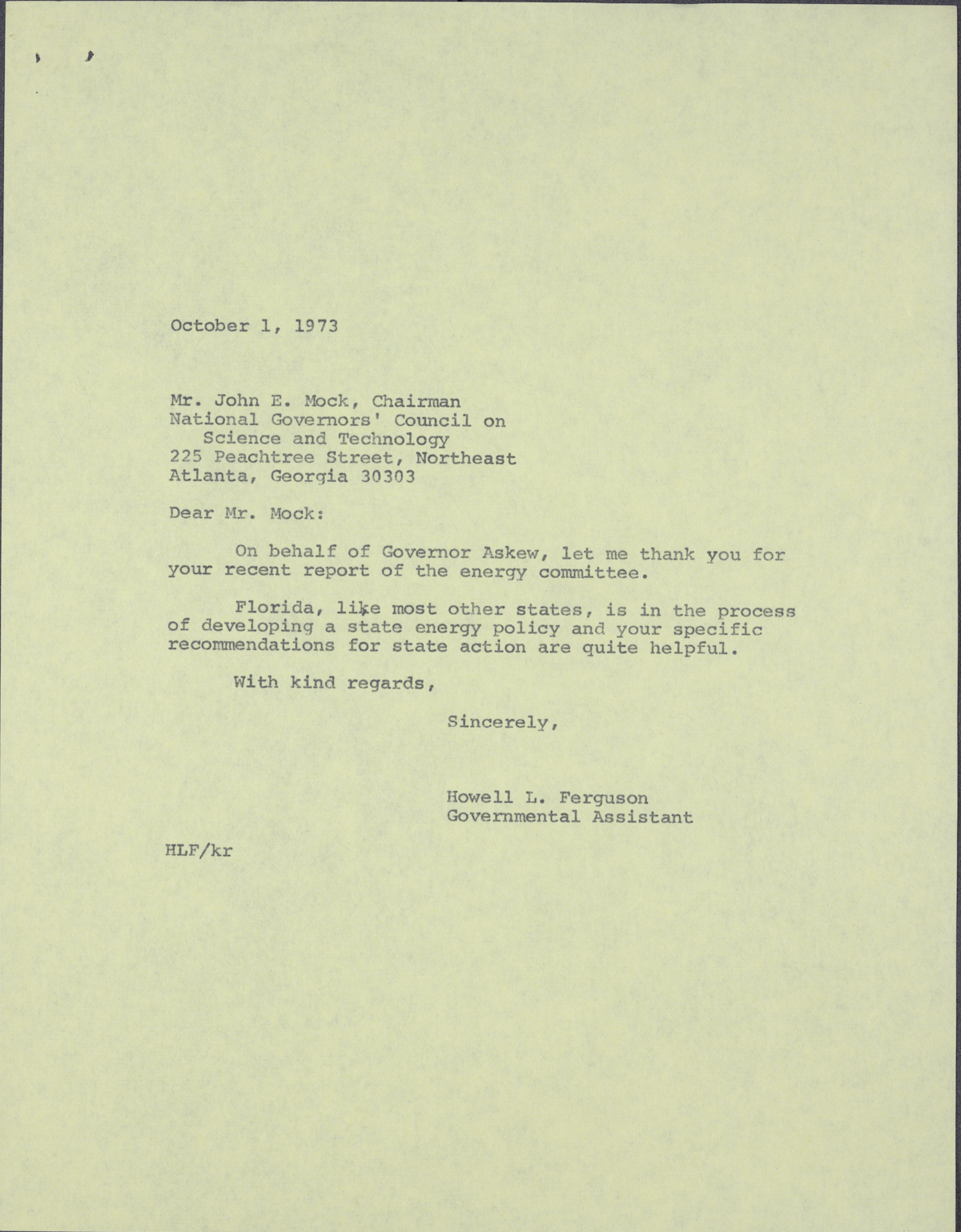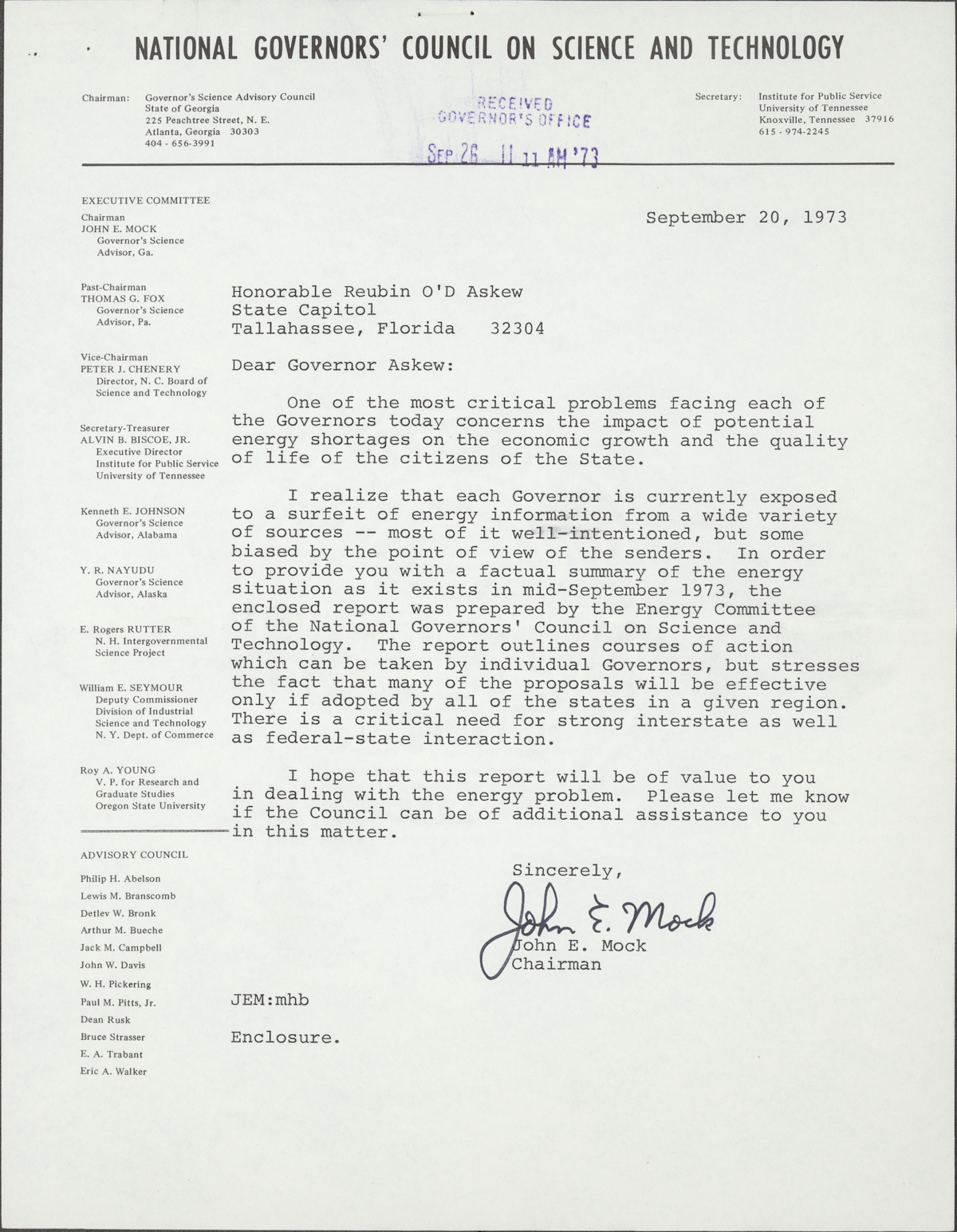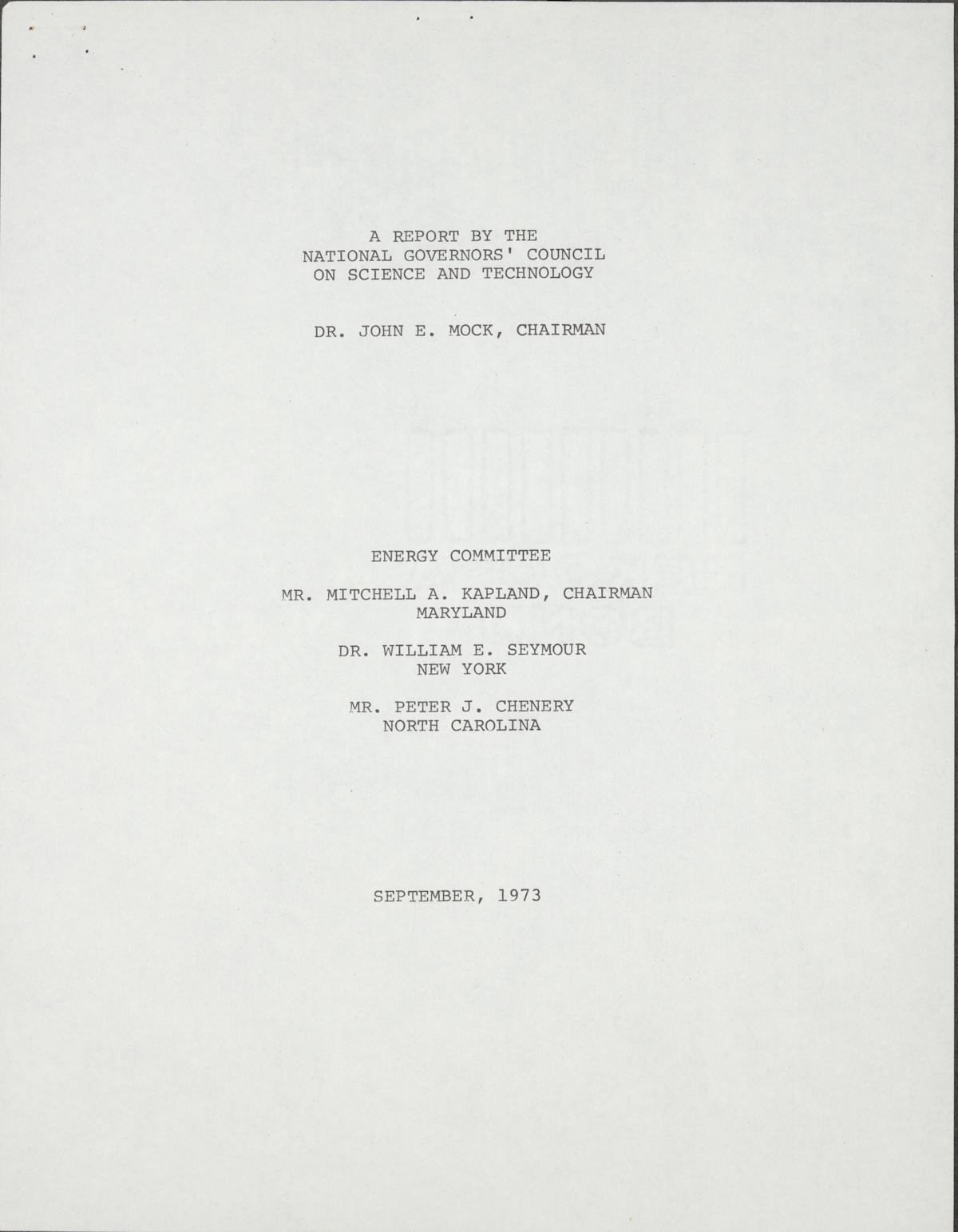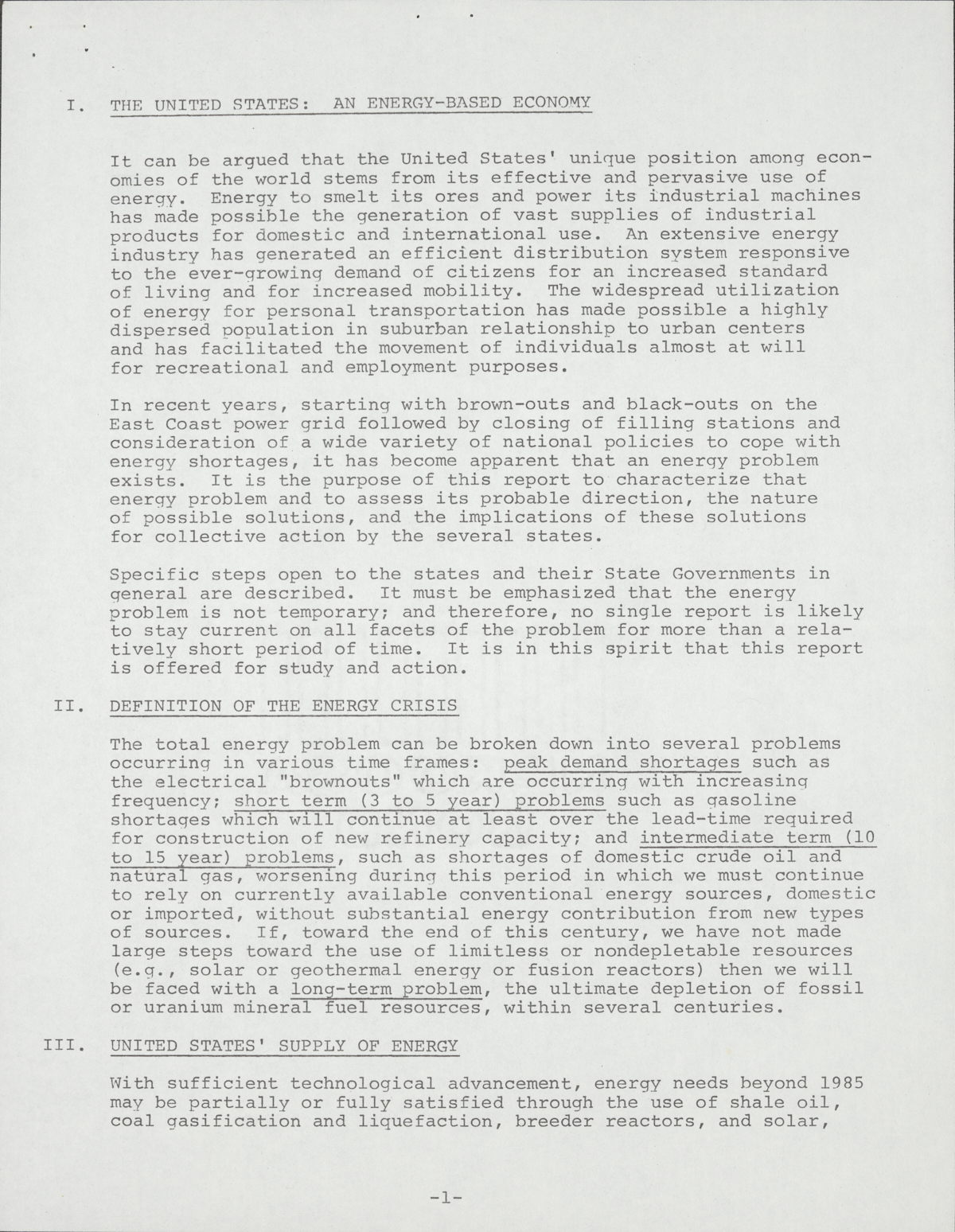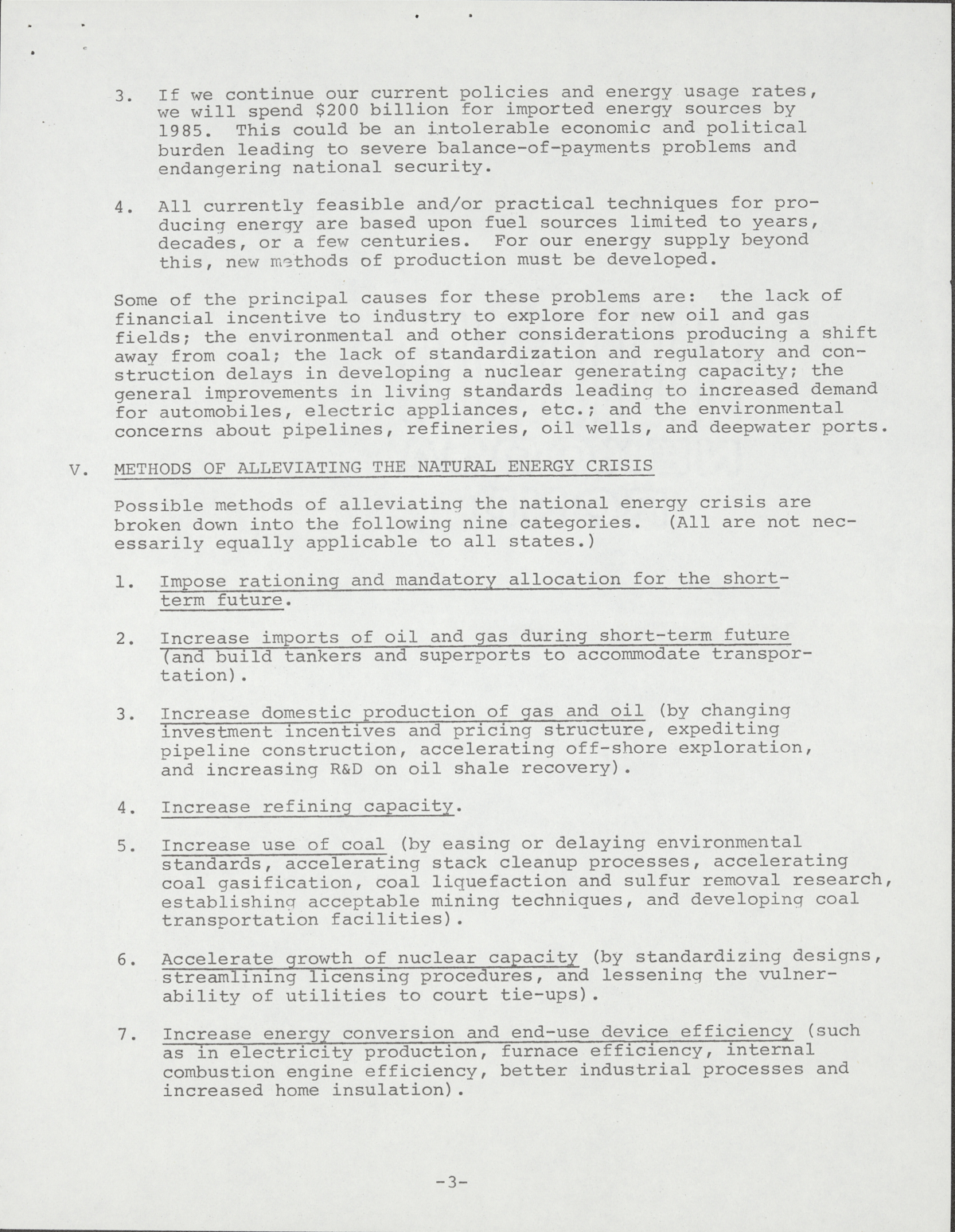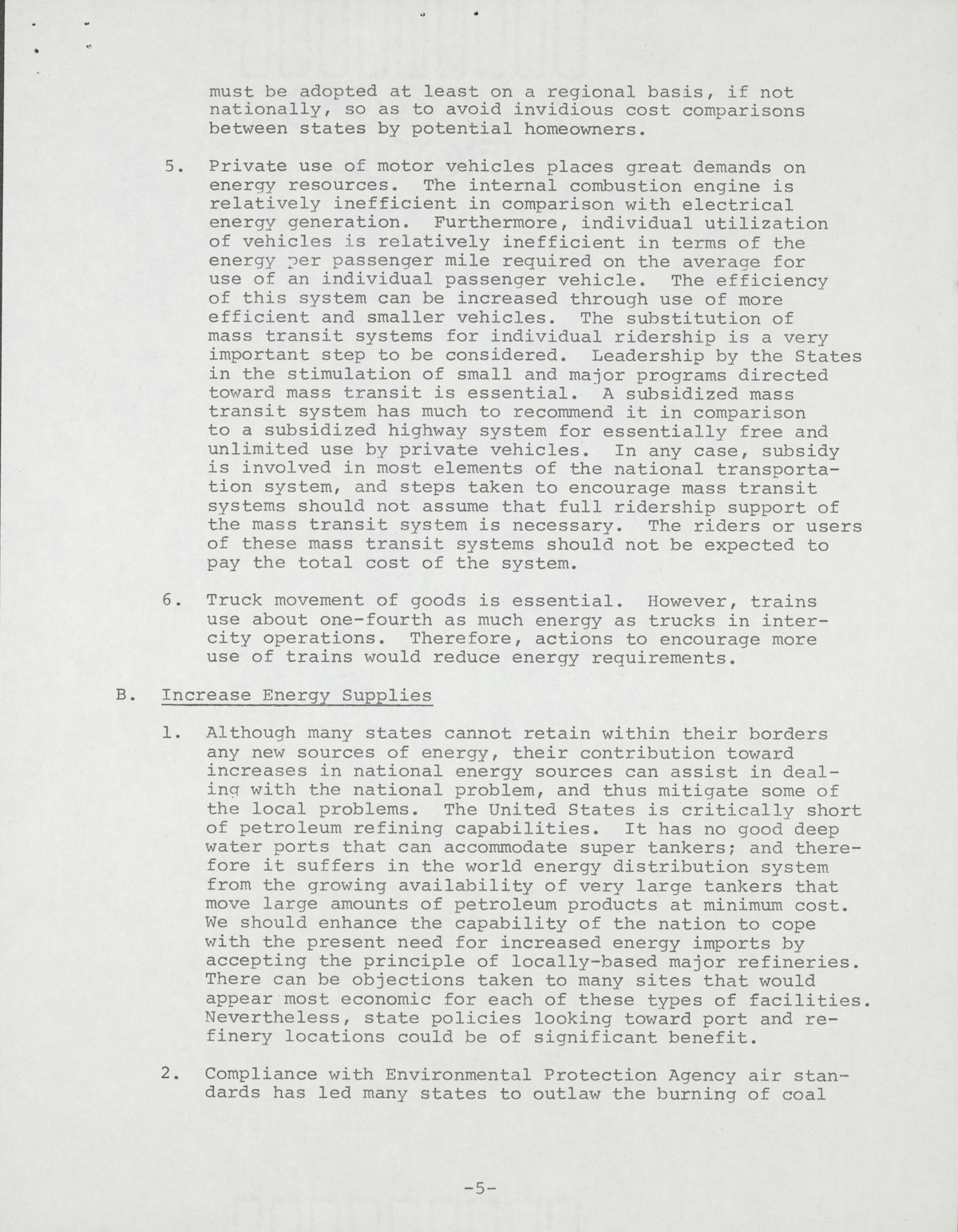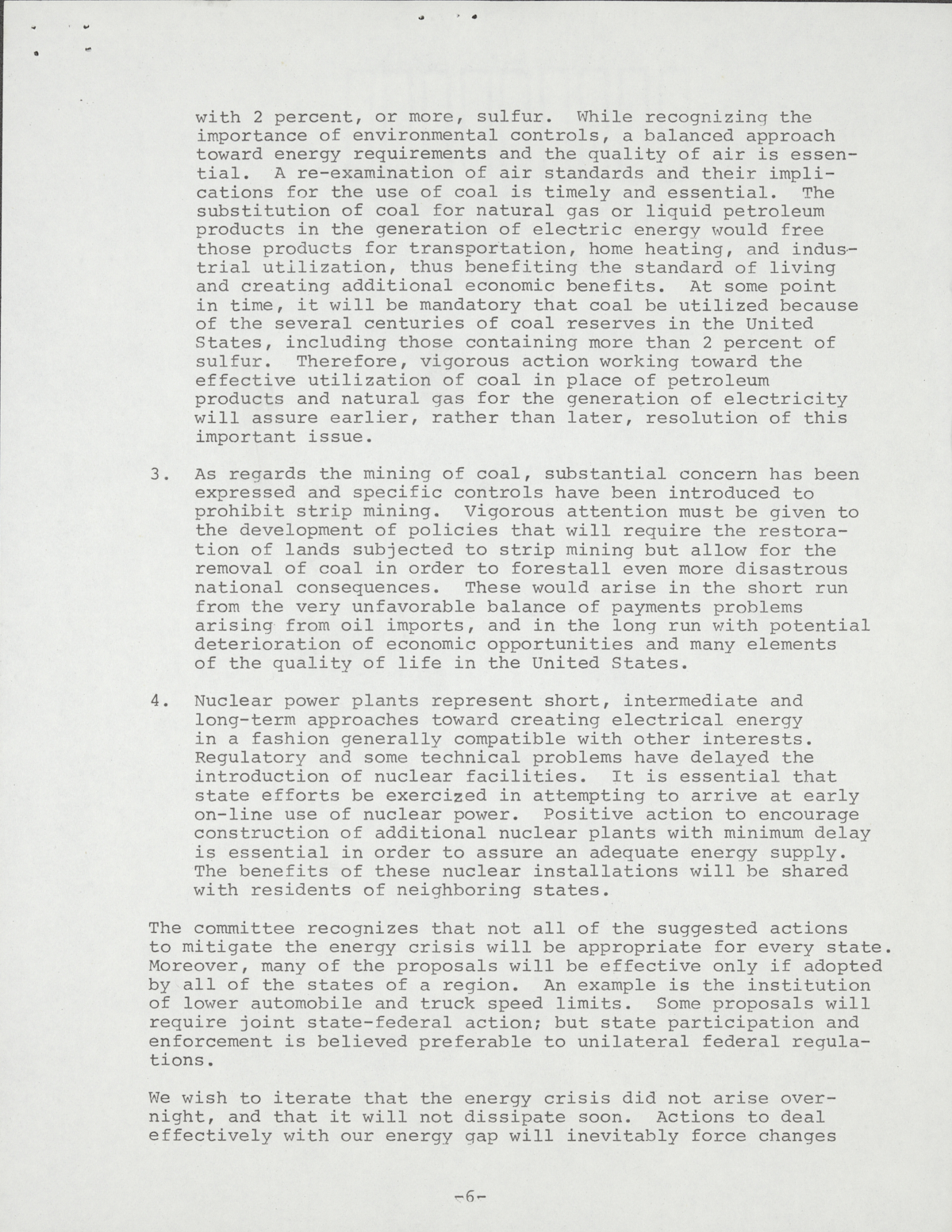Florida Memory is administered by the Florida Department of State, Division of Library and Information Services, Bureau of Archives and Records Management. The digitized records on Florida Memory come from the collections of the State Archives of Florida and the special collections of the State Library of Florida.

State Archives of Florida
- ArchivesFlorida.com
- State Archives Online Catalog
- ArchivesFlorida.com
- ArchivesFlorida.com
State Library of Florida
Related Sites
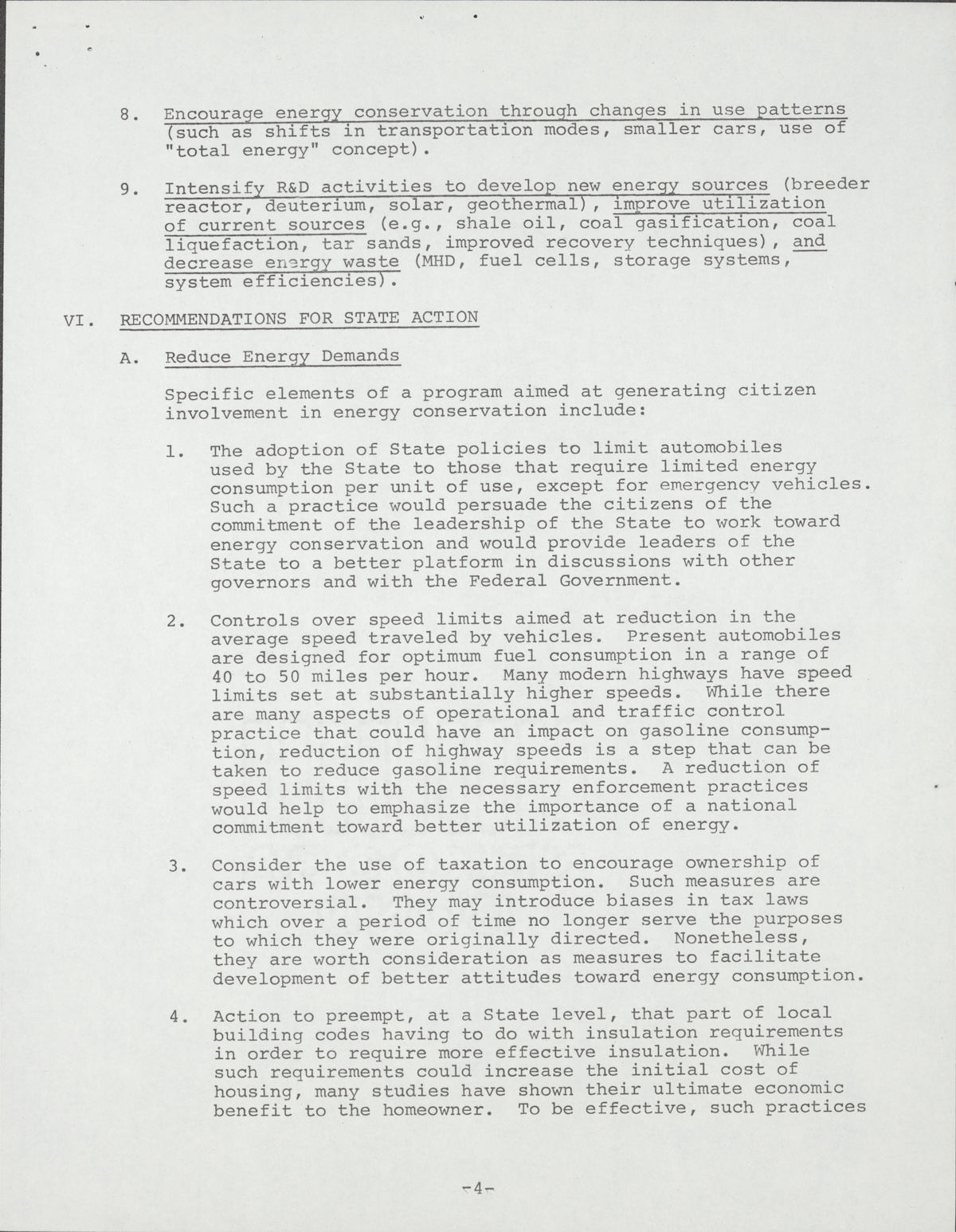
Description of previous item
Description of next item

Letters between John E. Mock, chairman of the National Governors' Council on Science and Technology and Governor Askew's administration regarding energy shortages, 1973
Source
Description
Date
Contributors
Format
Topic
Subjects
Geographic Term
General Note
In 1973, members of the Organization of Arab Petroleum Exporting Countries (OAPEC) placed an oil embargo on the United States in response to President Nixon’s support of Israel during the Yom Kippur War.
With energy shortages and skyrocketing prices, the United States had to create strategies for conserving fuel. President Nixon even created a new agency called the Federal Energy Office, later the Federal Energy Administration. Other tactics included reducing highway speed limits to 55 miles per hour, and putting the country on year-round Daylight Saving Time.
Although the oil embargo was lifted in March of 1974, the impacts of the crisis were felt throughout the rest of the decade. The United States was in an economic recession until 1975, and the country experienced a second energy crisis in 1979 in the aftermath of the Iranian Revolution.
9. Intensify R&D activities to develop new energy sources (breeder reactor, deuterium, solar, geothermal) , improve utilization of current sources (e.g., Shale oil, coal gasification, coal liquefaction, tar sands, improved recovery techniques), and decrease energy waste (MHD, fuel cells, storage systems, system efficiencies).
VI. RECOMMENDATIONS FOR STATE ACTION
A. Reduce Energy Demands
Specific elements of a program aimed at generating citizen involvement in energy conservation include:
1. The adoption of State policies to limit automobiles used by the State to those that require limited energy consumption per unit of use, except for emergency vehicles. Such a practice would persuade the citizens of the commitment of the leadership of the State to work toward energy conservation and would provide leaders of the State to a better platform in discussions with other governors and with the Federal Government.
2. Controls over speed limits aimed at reduction in the average speed traveled by vehicles. Present automobiles are designed for optimum fuel consumption in a range of 40 to 50 miles per hour. Many modern highways have speed limits set at substantially higher speeds. While there are many aspects of operational and traffic control practice that could have an impact on gasoline consumption, reduction of highway speeds is a step that can be taken to reduce gasoline requirements. A reduction of speed limits with the necessary enforcement practices would help to emphasize the importance of a national commitment toward better utilization of energy.
3. Consider the use of taxation to encourage ownership of cars with lower energy consumption. Such measures are controversial. They may introduce biases in tax laws which over a period of time no longer serve the purposes to which they were originally directed. Nonetheless, they are worth consideration as measures to facilitate development of better attitudes toward energy consumption.
4. Action to preempt, at a State level, that part of local building codes having to do with insulation requirements in order to require more effective insulation. While such requirements could increase the initial cost of housing, many studies have shown their ultimate economic benefit to the homeowner. To be effective, such practices
Title
Subject
Description
Creator
Source
Date
Contributor
Format
Language
Type
Identifier
Coverage
Geographic Term
Thumbnail
ImageID
topic
Subject - Corporate
Subject - Person
Transcript
Mr. John E. Mock, Chairman
National Governors' Council on Science and Technology
225 Peachtree Street, Northeast
Atlanta, Georgia 30303
Dear Mr. Mock:
On behalf of Governor Askew, let me thank you for your recent report of the energy committee.
Florida, like most other states, is in the process of developing a state energy policy and your specific recommendations for state action are quite helpful.
With kind regards,
Sincerely,
Howell L. Ferguson
Governmental Assistant
HLF/kr
Chairman: Governor’s Science Advisory Council
State of Georgia
225 Peachtree Street, N. E.
Atlanta Georgia 30303
404 – 656 – 3991
Secretary: Institute for Public Service
University of Tennessee
Knoxville, Tennessee 37916
615 - 974 - 2245
[Stamped] Received Governor’s Office
Sep 26 11 AM’73
September 20, 1973
Honorable Reubin O’D Askew
State Capitol
Tallahassee, Florida 32304
Dear Governor Askew:
One of the most critical problems facing each of the Governors today concerns the impact of potential energy shortages on the economic growth and the quality of life of the citizens of the State.
I realize that each Governor is currently exposed to a surfeit of energy information from a wide variety of sources -- most of it well-intentioned, but some biased by the point of view of the senders. In order to provide you with a factual summary of the energy situation as it exists in mid-September 1973, the enclosed report was prepared by the Energy Committee
of the National Governors' Council on Science and Technology. The report outlines courses of action which can be taken by individual Governors, but stresses the fact that many of the proposals will be effective only if adopted by all of the states in a given region. There is a critical need for strong interstate as well as federal-state interaction.
I hope that this report will be of value to you in dealing with the energy problem. Please let me know if the Council can be of additional assistance to you in this matter.
Sincerely,
[Signed] John E. Mock
John E. Mock
Chairman
JEM:mhb
Enclosure.
[side column listing members of the council]
Executive Committee
Chairman
JOHN E. MOCK
Governor’s Science Advisor, Ga.
Past-Chairman
THOMAS G. FOX
Governor’s Science Advisor, Pa.
Vice-Chairman
PETER J. CHENERY
Director, N. C. Board of Science and Technology
Secretary-Treasurer
ALVIN B. BISCOE, JR.
Executive Director Institute for Public Service
University of Tennessee
Kenneth E. JOHNSON
Governor’s Science Advisor, Alabama
Y. R. NAYUDU
Governor’s Science Advisor, Alaska
E. Rogers RUTTER
N. H. Intergovernmental Science Project
William E. SEYMOUR
Deputy Commissioner Division of Industrial Science and Technology
N. Y. Dept. of Commerce
Roy A. YOUNG
V. P. for Research and Graduate Studies
Oregon State University
ADVISORY COUNCIL
Philip H. Abelson
Lewis M. Branscomb
Detlev W. Bronk
Arthur M. Bueche
Jack M. Campbell
John W. Davis
W. H. Pickering
Paul M. Pitts, Jr.
Dean Rusk
Bruce Strasser
E. A. Trabant
Eric A. Walker
DR. JOHN E. MOCK, CHAIRMAN
ENERGY COMMITTEE
MR. MITCHELL A. KAPLAND, CHAIRMAN
MARYLAND
DR. WILLIAM E. SEYMOUR
NEW YORK
MR. PETER J. CHENERY
NORTH CAROLINA
SEPTEMBER, 1973
It can be argued that the United States' unique position among economies of the world stems from its effective and pervasive use of energy. Energy to smelt its ores and power its industrial machines has made possible the generation of vast supplies of industrial products for domestic and international use. An extensive energy industry has generated an efficient distribution system responsive to the ever-growing demand of citizens for an increased standard of living and for increased mobility. The widespread utilization of energy for personal transportation has made possible a highly dispersed population in suburban relationship to urban centers and has facilitated the movement of individuals almost at will for recreational and employment purposes.
In recent years, starting with brown-outs and black-outs on the East Coast power grid followed by closing of filling stations and consideration of a wide variety of national policies to cope with energy shortages, it has become apparent that an energy problem exists. It is the purpose of this report to characterize that energy problem and to assess its probable direction, the nature of possible solutions, and the implications of these solutions for collective action by the several states.
Specific steps open to the states and their State Governments in general are described. It must be emphasized that the energy problem is not temporary; and therefore, no single report is likely to stay current on all facets of the problem for more than a relatively short period of time. It is in this spirit that this report is offered for study and action.
II. DEFINITION OF THE ENERGY CRISIS
The total energy problem can be broken down into several problems occurring in various time frames: peak demand shortages such as the electrical "brownouts" which are occurring with increasing frequency; short term (3 to 5 year) problems such as gasoline shortages which will continue at least over the lead-time required for construction of new refinery capacity; and intermediate term (10 to 15 year) problems, such as shortages of domestic crude oil and natural gas, worsening during this period in which we must continue to rely on currently available conventional energy sources, domestic or imported, without substantial energy contribution from new types of sources. If, toward the end of this century, we have not made large steps toward the use of limitless or nondepletable resources (e.g., solar or geothermal energy or fusion reactors) then we will be faced with a long-term problem, the ultimate depletion of fossil or uranium mineral fuel resources, within several centuries.
III. UNITED STATES' SUPPLY OF ENERGY
With sufficient technological advancement, energy needs beyond 1985 may be partially or fully satisfied through the use of shale oil, coal gasification and liquefaction, breeder reactors, and solar,
Domestic Natural Gas reserves have been decreasing rapidly, and would last only 10 years at the current usage rate if no further reserves were discovered. This is largely because Government regulation of low gas prices has stimulated demand but provided no incentive for exploration and development.
Domestic Oil reserves, including the Alaskan North Slope, also represent 10 years of current oil use based on proved established reserves. For all of this oil to be available in that time period, the Alaskan pipeline development would have to proceed soon.
Domestic Coal can be a plentiful national energy source for hundreds of years. However, its future use and availability depends on reaching agreement on ways to deal with sulfur dioxide and particulate pollutants and the environmental problems associated with strip-mining and on expanding transportation facilities.
Nuclear plants could provide more than 10% of the total 1985 energy requirement, if their construction could proceed on a standardized basis without regulatory delays due to questions of siting, safety, and environmental impact.
Under these considerations, rational analysis shows that the gap between future domestic energy supplies and projected demands can only be filled by increasing our oil and gas imports. In the most probable case, such imports will represent 23% of our total energy requirements in 1975, 26% in 1980, and 29% in 1985. This latter figure represents 60% of our total oil requirements in that year.
These tentative conclusions may be affected or changed by achievement of technological advanced sooner than presently forecast. We can change our transportation habits, space heating requirements, energy conversion efficiencies, and exploration policies. We can accept or mitigate some of the environmental aspects associated with the use of coal.
IV. PRINCIPAL U. S. ENERGY PROBLEMS
The primary problems which constitute the "energy crisis" may now be identified more precisely:
1. The capacity for meeting peak electric power demand is currently marginal. If power plant construction schedules are delayed (as is often the case with nuclear power plants), brownouts and black-outs could become frequent. :
2. Petroleum refinery capacity is critically short. Unless strong conservation measures or a rationing system is adopted, we will be unable to satisfy our demand through 1975, even with maximum importation of refined products.
4. All currently feasible and/or practical techniques for producing energy are based upon fuel sources limited to years, decades, or a few centuries. For our energy supply beyond this, new methods of production must be developed.
Some of the principal causes for these problems are: the lack of financial incentive to industry to explore for new oil and gas fields; the environmental and other considerations producing a shift away from coal; the lack of standardization and regulatory and construction delays in developing a nuclear generating capacity; the general improvements in living standards leading to increased demand for automobiles, electric appliances, etc.; and the environmental concerns about pipelines, refineries, oil wells, and deepwater ports.
V. METHODS OF ALLEVIATING THE NATURAL ENERGY CRISIS
Possible methods of alleviating the national energy crisis are broken down into the following nine categories. (All are not necessarily equally applicable to all states.)
1. Impose rationing and mandatory allocation for the short-term future.
2. Increase imports of oil and gas during short-term future (and build tankers and superports to accommodate transportation).
3. Increase domestic production of gas and oil (by changing investment incentives and pricing structure, expediting pipeline construction, accelerating off-shore exploration, and increasing R&D on oil shale recovery).
4. Increase refining capacity.
5. Increase use of coal (by easing or delaying environmental standards, accelerating stack cleanup processes, accelerating coal gasification, coal liquefaction and sulfur removal research, establishing acceptable mining techniques, and developing coal transportation facilities).
6. Accelerate growth of nuclear capacity (by standardizing designs, streamlining licensing procedures, and lessening the vulnerability of utilities to court tie-ups).
7. Increase energy conversion and end-use device efficiency (such as in electricity production, furnace efficiency, internal combustion engine efficiency, better industrial processes and increased home insulation).
9. Intensify R&D activities to develop new energy sources (breeder reactor, deuterium, solar, geothermal) , improve utilization of current sources (e.g., Shale oil, coal gasification, coal liquefaction, tar sands, improved recovery techniques), and decrease energy waste (MHD, fuel cells, storage systems, system efficiencies).
VI. RECOMMENDATIONS FOR STATE ACTION
A. Reduce Energy Demands
Specific elements of a program aimed at generating citizen involvement in energy conservation include:
1. The adoption of State policies to limit automobiles used by the State to those that require limited energy consumption per unit of use, except for emergency vehicles. Such a practice would persuade the citizens of the commitment of the leadership of the State to work toward energy conservation and would provide leaders of the State to a better platform in discussions with other governors and with the Federal Government.
2. Controls over speed limits aimed at reduction in the average speed traveled by vehicles. Present automobiles are designed for optimum fuel consumption in a range of 40 to 50 miles per hour. Many modern highways have speed limits set at substantially higher speeds. While there are many aspects of operational and traffic control practice that could have an impact on gasoline consumption, reduction of highway speeds is a step that can be taken to reduce gasoline requirements. A reduction of speed limits with the necessary enforcement practices would help to emphasize the importance of a national commitment toward better utilization of energy.
3. Consider the use of taxation to encourage ownership of cars with lower energy consumption. Such measures are controversial. They may introduce biases in tax laws which over a period of time no longer serve the purposes to which they were originally directed. Nonetheless, they are worth consideration as measures to facilitate development of better attitudes toward energy consumption.
4. Action to preempt, at a State level, that part of local building codes having to do with insulation requirements in order to require more effective insulation. While such requirements could increase the initial cost of housing, many studies have shown their ultimate economic benefit to the homeowner. To be effective, such practices
5. Private use of motor vehicles places great demands on energy resources. The internal combustion engine is relatively inefficient in comparison with electrical energy generation. Furthermore, individual utilization of vehicles is relatively inefficient in terms of the energy per passenger mile required on the average for use of an individual passenger vehicle. The efficiency of this system can be increased through use of more efficient and smaller vehicles. The substitution of mass transit systems for individual ridership is a very important step to be considered. Leadership by the States in the stimulation of small and major programs directed toward mass transit is essential. A subsidized mass transit system has much to recommend it in comparison to a subsidized highway system for essentially free and unlimited use by private vehicles. In any case, subsidy is involved in most elements of the national transportation system, and steps taken to encourage mass transit systems should not assume that full ridership support of the mass transit system is necessary. The riders or users of these mass transit systems should not be expected to pay the total cost of the system.
6. Truck movement of goods is essential. However, trains use about one-fourth as much energy as trucks in inter-city operations. Therefore, actions to encourage more use of trains would reduce energy requirements.
B. Increase Energy Supplies
1. Although many states cannot retain within their borders any new sources of energy, their contribution toward increases in national energy sources can assist in dealing with the national problem, and thus mitigate some of the local problems. The United States is critically short | of petroleum refining capabilities. It has no good deep water ports that can accommodate super tankers; and therefore it suffers in the world energy distribution system from the growing availability of very large tankers that move large amounts of petroleum products at minimum cost. We should enhance the capability of the nation to cope with the present need for increased energy imports by accepting the principle of locally-based major refineries. There can be objections taken to many sites that would appear most economic for each of these types of facilities. Nevertheless, state policies looking toward port and refinery locations could be of significant benefit.
2. Compliance with Environmental Protection Agency air standards has led many states to outlaw the burning of coal
3. As regards the mining of coal, substantial concern has been expressed and specific controls have been introduced to prohibit strip mining. Vigorous attention must be given to the development of policies that will require the restoration of lands subjected to strip mining but allow for the removal of coal in order to forestall even more disastrous national consequences. These would arise in the short run from the very unfavorable balance of payments problems arising from oil imports, and in the long run with potential deterioration of economic opportunities and many elements of the quality of life in the United States.
4. Nuclear power plants represent short, intermediate and long-term approaches toward creating electrical energy in a fashion generally compatible with other interests. Regulatory and some technical problems have delayed the introduction of nuclear facilities. It is essential that state efforts be exercized [sic.] in attempting to arrive at early on-line use of nuclear power. Positive action to encourage construction of additional nuclear plants with minimum delay 1s essential in order to assure an adequate energy supply. The benefits of these nuclear installations will be shared with residents of neighboring states.
The committee recognizes that not all of the suggested actions to mitigate the energy crisis will be appropriate for every state. Moreover, many of the proposals will be effective only if adopted by all of the states of a region. An example is the institution of lower automobile and truck speed limits. Some proposals will require joint state-federal action; but state participation and enforcement is believed preferable to unilateral federal regulations.
We wish to iterate that the energy crisis did not arise overnight, and that it will not dissipate soon. Actions to deal effectively with our energy gap will inevitably force changes
General Note
In 1973, members of the Organization of Arab Petroleum Exporting Countries (OAPEC) placed an oil embargo on the United States in response to President Nixon’s support of Israel during the Yom Kippur War.
With energy shortages and skyrocketing prices, the United States had to create strategies for conserving fuel. President Nixon even created a new agency called the Federal Energy Office, later the Federal Energy Administration. Other tactics included reducing highway speed limits to 55 miles per hour, and putting the country on year-round Daylight Saving Time.
Although the oil embargo was lifted in March of 1974, the impacts of the crisis were felt throughout the rest of the decade. The United States was in an economic recession until 1975, and the country experienced a second energy crisis in 1979 in the aftermath of the Iranian Revolution.
Chicago Manual of Style
Ferguson, Howell L. Letters between John E. Mock, chairman of the National Governors' Council on Science and Technology and Governor Askew's administration regarding energy shortages, 1973. 1973. State Archives of Florida, Florida Memory. <https://www.floridamemory.com/items/show/350883>, accessed 27 December 2025.
MLA
Ferguson, Howell L. Letters between John E. Mock, chairman of the National Governors' Council on Science and Technology and Governor Askew's administration regarding energy shortages, 1973. 1973. State Archives of Florida, Florida Memory. Accessed 27 Dec. 2025.<https://www.floridamemory.com/items/show/350883>
AP Style Photo Citation
(State Archives of Florida/Ferguson)

 Listen: The World Program
Listen: The World Program